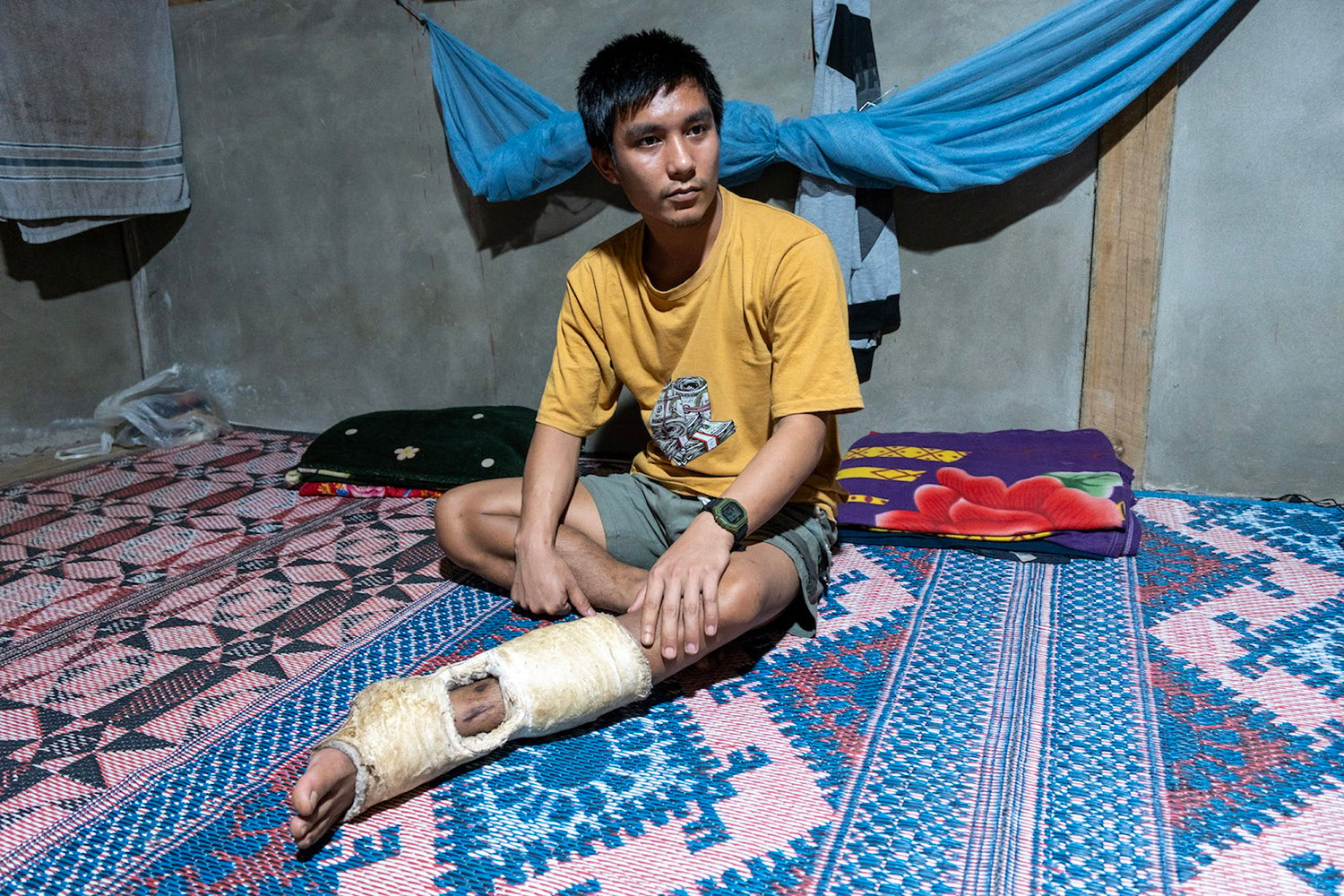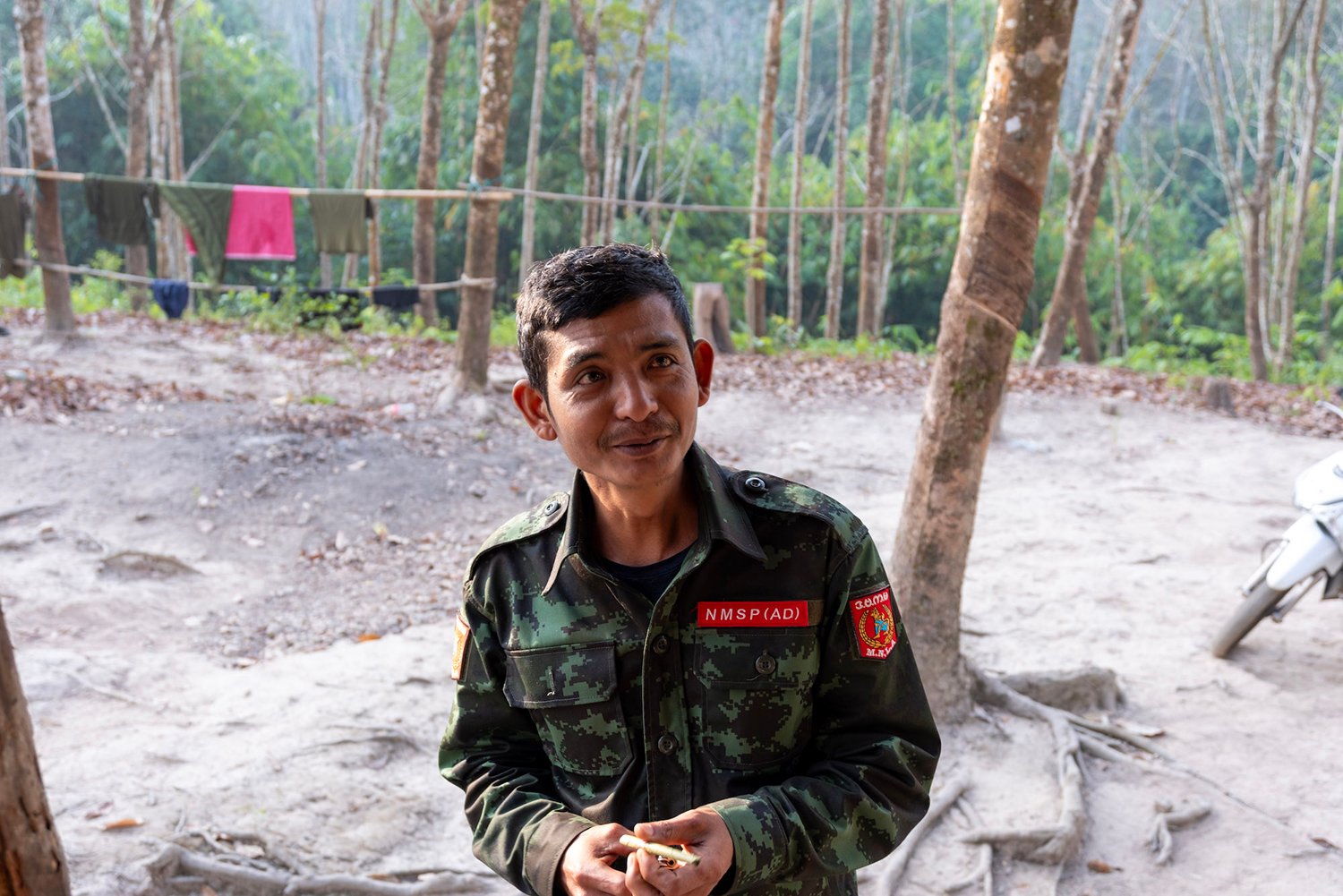MON AND KAYIN STATES, Myanmar—Before the 2021 military coup in Myanmar, Nai Kyi San’s only firsthand combat experience was fighting against another rebel group: the Karen National Liberation Army (KNLA). “I don’t think about that now because based on the current situation, they are our allies, and our cooperation is very important,” he said.
Nai Kyi San—now a regional commander of the New Mon State Party (NMSP)—was 19 years old during that territorial skirmish, in 1988. Now his black hair is giving way to gray, and the veteran rebel commander has a different enemy in his sights: Myanmar’s military junta.
The NMSP began fighting for the political autonomy of the Mon ethnic minority in 1959. The group signed a cease-fire with Myanmar’s military government in 1995 in exchange for official recognition of its territory in southeastern Myanmar, including a cluster of Mon villages in Kayin state that Foreign Policy visited in February.
The presence of Mon villages in Kayin state and Karen villages in Mon state is a source of tension between the NMSP and KNLA, particularly when it comes to local governance and tax collection, with clashes taking place as recently as 2019. But today, the two groups launch operations against the Myanmar military together, with the KNLA providing strategic advice, specialist training, and even weapons to the NMSP.
The NMSP is still playing catch-up because it has limited battlefield experience and because it was slow to join the fight after the coup. Though the KNLA immediately started fighting the military after it seized power, overthrowing leader Aung San Suu Kyi’s democratically elected government, the NMSP continued to honor its cease-fire, hoping to protect its core territories from the conflict engulfing the rest of the country.
But in the last year, two of the NMSP’s military divisions split off to join the fight against the junta, a move that was welcomed by many members of the Mon nationalist movement. The breakaway faction was rewarded with a surge of young recruits who wanted to fight the military regime but were waiting for guidance from the NMSP leadership.

Kyaw Zin Latt, 28, was a bricklayer until one year ago. Though many pro-democracy militias formed after the military takeover, he only considered joining the NMSP. He described how after the coup, soldiers burned down homes, abducted villagers for forced labor, and confiscated private property in Mon areas.
“There are no troops that represent the Mon people in the Myanmar military, so we need to have our own Mon troops to represent and guard Mon state,” Kyaw Zin Latt said.
Though the military largely honored the 1995 cease-fire in the NMSP’s recognized territories after the coup, the quality of life deteriorated anyway, said Chan Aye, 27, a civilian resident of one of the Mon villages in Kayin state.
Electricity was cut to these villages more than a year ago. The junta struggles to produce enough power, and commodity prices have skyrocketed across Myanmar. More ominously, a large military checkpoint on the road to Mawlamyine, the Mon state capital, means that many people are essentially confined to this small territory. “Nobody living in this area would travel outside it unless they have a really important reason,” Chan Aye said.

At these checkpoints, security forces subject travelers to thorough searches and can arrest them for having banned social media platforms, such as Facebook, on their phones. Being searched is particularly risky for someone such as Chan Aye because the military increasingly uses these arrests as a pretext to forcibly conscript young men.
Against this backdrop, it may seem obvious that oppressed minority groups would put aside their differences to take on the military, but it hasn’t always played out that way. Myanmar’s junta has proved adept at leveraging existing ethnic and religious tensions to its own benefit.
Not far from Mon and Kayin states, the military has exploited Buddhist Pa-O fears about Roman Catholic Karenni encroaching on their lands. The Pa-O National Army helped the regime expel the pro-democracy Karenni Nationalities Defense Force (KNDF) from key parts of southern Shan state, allowing it to stop the KNDF from fully seizing the Kayah state capital last year.
On the other side of the country, the military armed Rohingya Muslim militant groups and conscripted Rohingya civilians to fight against the Rakhine Buddhist Arakan Army, after the latter group moved into Rohingya-majority townships. This was an extraordinary turnaround, given the military’s past atrocities against Rohingya civilians, at times assisted by Rakhine vigilantes.
Banyal Leir, a leader of the NMSP breakaway faction, said the Myanmar military tried to entice the NMSP to “protect” Mon villages from the KNLA and pro-democracy forces, but they never took the bait.
However, for those groups that avoid this divide-and-conquer trap and manage to push out the military, another danger lurks: the power vacuum. With the military almost completely expelled from northern Shan state, for example, tensions have boiled over between former allies: the Kachin Independence Army (KIA) and the Taang National Liberation Army (TNLA).
In the last 18 months, the TNLA has conquered a stretch of ethnically diverse territory that includes areas with sizable Kachin populations where the KIA has long had a presence. These two rebel groups have been among the most successful since the coup, but that has brought new challenges. Videos have emerged of the two groups engaged in fistfights and stone throwing in disputed areas, though the lack of live rounds indicates continued restraint.

But the NMSP still has a long way to go to replicate the victories in the north. Foreign Policy also visited NMSP camps near the Mon state front lines in the chilly mountains of Mudon township and the plains of Kyaikmaraw township in February. Both camps, set among the rubber plantations that cover much of the region, had the same objective: ambushing soldiers when they leave their base, to keep them confined while the NMSP expands its influence.
Kwot Sar, 39, came out of retirement to rejoin the breakaway NMSP faction after the split. “If the Mon don’t take part in this moment, when the military falls and we talk about ethnic rights and politics at a national level, it will be harder for us to demand anything, and we could be left behind,” he said.

That fear is real in a conflict that has largely followed the right of conquest. The TNLA is one of the most powerful armed groups in Myanmar but represents a relatively small ethnic group. Few in the broader anti-junta movement have challenged the TNLA’s right to administer the lands it has seized, despite the controversy with the KIA.
But members of the NMSP remained optimistic that any future disputes with the KNLA could be resolved peacefully. They insist they can hold a dialogue with anyone—except the military. “It’s not going to be easy. There will definitely be some tension,” Kwot Sar said. “But we have to solve it. If either Mon or Karen take control of this area and rule democratically and respect human rights, it will be alright.”
The post Rivals Unite in Myanmar’s Southeast appeared first on Foreign Policy.




